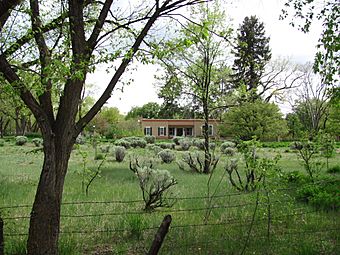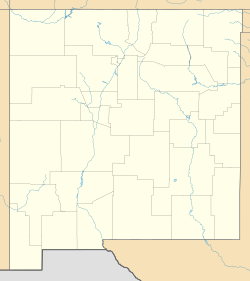Camino del Monte Sol Historic District facts for kids
Quick facts for kids |
|
|
Camino del Monte Sol Historic District
|
|
 |
|
| Location | Roughly bounded by Acequia Madre, Camino del Monte Sol, El Caminito, and Garcia St., Santa Fe, New Mexico |
|---|---|
| Area | 52.1 acres (21.1 ha) |
| Architect | John Gaw Meem |
| Architectural style | Late 19th and Early 20th Century American Movements, Pueblo, Territorial Revival |
| NRHP reference No. | 88000440 |
| Added to NRHP | July 11, 1988 |
The Camino del Monte Sol Historic District in Santa Fe, New Mexico, is a special area recognized for its history. It covers about 52 acres (21 hectares). This district was added to the National Register of Historic Places in 1988. This means it's an important place to protect. It includes 106 buildings that help tell its story.
You can find buildings designed by famous architect John Gaw Meem here. Also, many homes were built by well-known artists, even if they weren't trained architects.
This historic area is in the southeast part of Santa Fe. It's located south of the Santa Fe River. It also stretches south of the Acequia Madre, which is an old irrigation ditch. Most of its streets run north and south. It is next to the Santa Fe Historic District. The district's borders are roughly Acequia Madre, Camino del Monte Sol, El Caminito, and Garcia Street.
Contents
Why is Camino del Monte Sol Special?
A Home for Artists and Writers
The Camino del Monte Sol area became very important after New Mexico became a state in 1912. Until World War II, it was a famous place for artists and writers. Many of these creative people were already well-known across the country. They chose to live in this quiet, less-known part of New Mexico.
These artists made big contributions to their fields, like writing and painting. They also helped shape Santa Fe into the unique city it is today. Even though it's not an "artist colony" anymore, many creative people still live in Santa Fe. They continue to add to its special character.
Santa Fe's Unique Charm
Santa Fe is a popular place for tourists. People visit for its many art galleries. These galleries often show art by Native American and Spanish artists. Visitors also love the city's yearly markets and traditions, like the annual Fiesta.
A big part of Santa Fe's charm comes from its special architecture. The artists who first came to Santa Fe were drawn to the area's old cultures. They worked hard to save and bring back the traditional arts, crafts, customs, and building styles of those cultures.
How Artists Shaped Santa Fe's Buildings
The artists' community had a huge impact on Santa Fe's architecture. There was already a movement to save and rebuild the city's historic adobe buildings. But the artists joined in with great energy. They led efforts to protect old buildings. They also built their own homes in the Pueblo Revival style. This style looks like traditional Native American adobe homes.
The district also has some of the first houses designed by John Gaw Meem. He was a top architect who helped create these revival styles. Unlike Canyon Road, which became mostly shops, Camino del Monte Sol stayed a neighborhood where people live. The artists' homes here are a special collection of Pueblo Revival and Territorial Revival houses. These artists played a big role in making Santa Fe a city known for its historic building styles.
Who Lived in This Historic District?
Many important artists and writers lived in the Camino del Monte Sol Historic District. They helped create its unique artistic and cultural feel. Here are some of the key figures:
- Alice Corbin Henderson (1881-1949) and William Penhallow Henderson (1877-1943) lived at 555 and 557 Camino del Monte Sol.
- Frank Applegate lived at 830 El Caminito, 831 El Caminito, and 408 Camino del Monte Sol.
- Fremont Ellis lived at 586 Camino del Monte Sol.
- Walter Mruk lived at 542 Camino del Monte Sol.
- Joseph Bakos (1891-1977) lived at 576 Camino del Monte Sol.
- Willard Nash (1898-1943) lived at 566 Camino del Monte Sol.
- Will Shuster lived at 580 Camino del Monte Sol.
- Andrew Dasburg (1887–1979) lived at 520 and 524 Camino del Monte Sol.
- Datus Myers and Alice Clark Myers lived at 503 Camino del Monte Sol.
- Mary Hunter Austin (1868-1934) lived at 439 Camino del Monte Sol.
- Alfred Morang (1901-1958) lived at 1 Placita Rafaela.
- Lynn Riggs (1899-1954) lived at 770 Acequia Madre Road.
- Philip Stevenson (died 1965) lived at 408 Delgado Street. He was a novelist and screenwriter. He bought the home in 1930 and lived there until about 1939.
- Elizabeth De Huff lived at 828 Camino del Poniente.
The Stevenson Home and Children's Patio Day School
The home at 408 Delgado Street had a long history. A Garcia family owned it from 1848 to 1920. Later, in 1954, John Gaw Meem remodeled the eastern part of the property for Marian Gebhardt.
Marian Gebhardt made it her home. She also started a well-known place called the Children's Patio Day School there. She created an L-shaped addition by connecting an old adobe building to the house. You can still see the pegs where the children used to hang their coats!
Images for kids



